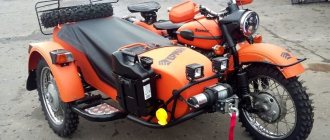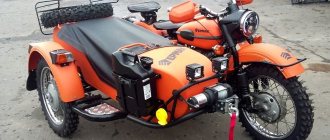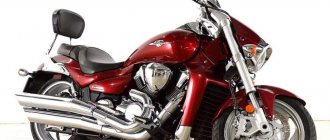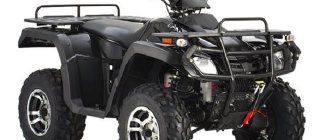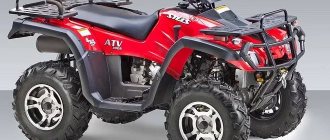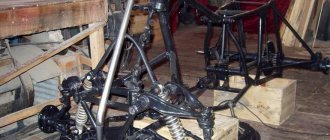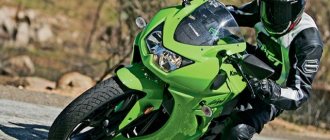Hello.
Let's start our big excursion into the world of all-wheel drive motorcycles with a general article on Visordown. This is, as usual, a quick review of motorcycles on a given topic.
The concept of an all-wheel drive motorcycle has been around for a long time, and many manufacturers have tried toying with the idea over the years. But an adequate offer for the sale of such motorcycles never materialized. This means that it is still impossible to judge the success of this concept.
Once upon a time, something similar happened in the automotive market, and many manufacturers who assumed that all-wheel drive vehicles had no place in the civilian market were proven wrong.
The flood of the automotive market with four-wheel drive vehicles occurred immediately after World War II, when ex-army jeeps found support among farmers and rural residents who appreciated the cross-country ability of such vehicles. Rover was the first company to notice the trend, and in 1948 Land Rover was released - the first and correct attempt to “fence” the army SUV. Over the next three decades, many other firms joined the competition for the four-wheel drive market. In the late 1970s, Audi became the first company to break the perception of four-wheel drive vehicles as purely off-road vehicles, and the 80s saw the dawn of the Quattro model.
Considering that Land Rover and Audi have both been hugely successful as pioneers in the four-wheel drive market (along with others such as Jeep and Subaru), it is surprising that no motorcycle manufacturer has made any serious effort to create an all-wheel drive motorcycle. This is all the more surprising considering that some of the niche 2WD motorcycles have received rave reviews, and the prototype 4WD motorcycles from major firms often impress with their performance.
So here's our list of the ten best all-wheel drive creations on the motorcycle market, be it production bikes, conversion kits, or prototypes that didn't make it to production.
Ural sidecar outfit.
Okay, this is definitely a scam! After all, this motorcycle has three wheels, so two drive wheels does not mean that it is all-wheel drive. However, this is perhaps the closest thing to a Jeep on this list. Like civilian jeeps, the post-World War II Ural is a descendant of military vehicles - the German BMW R75 and its almost identical Russian military rival from the same era. Still in production today, it is probably the most successful 2WD motorcycle ever designed, although not quite up to par with today's requirements.
DIY custom
It is extremely difficult to install full-fledged all-wheel drive on a motorcycle with your own hands. Such custom cars exist, and there are quite a lot of them, but almost all of them are only capable of driving ten meters in a straight line at some show, and they are not suitable for real use. There are, however, exceptions, such as the famous custom “ Arhar ” from the Moscow studio “Vilar-Pro. The bike looks unprepossessing in the photo, but it is really capable of driving on almost any off-road terrain. Moreover, it was no longer produced in a single copy, since bikers appreciated the motorcycle, and orders for the next copy began to arrive regularly to the custom creators. If its next version can be equipped with suspensions that are currently missing, it will be absolutely wonderful.
Suzuki XF5.
Back in the late 80s and early 90s, it looked like Suzuki could become the company capable of bringing about the quattro revolution in motorcycle construction. The company showed a whole range of all-wheel drive concept bikes, and in 1991 it released three models based on the same technology. There was the utilitarian XF4, the ugly bastard of the scooter and duck Xf425 and the XF5 enduro. For our selection, we chose the 200cc two-stroke XF5 because it was the concept with the most compelling design. The front wheel drive system of the motorcycle consisted of a telescopic drive shaft running along the left fork leg of the motorcycle. The shaft itself was driven by a chain system. The whole structure added 7.8 kg to the weight of the motorcycle.
Front-wheel drive operation via one telescopic shaft
In the mid-80s, Suzuki experimented with creating an all-wheel drive bike, trying out different options. As a result, from the beginning of the 90s they decided to use a telescopic shaft along the front stay. However, the design turned out to be complex and impractical, so it did not go into mass production.
Enduro XF5 remains a concept
Rokon.
While the Ural is without a doubt the most successful production two-wheel drive motorcycle, the Rokon, in production since the '60s, is the closest thing to attempting to produce a Land Rover on two wheels. Unfortunately, for most of its history, the Rokon got around the problem of combining front wheel drive and front suspension by simply getting rid of the suspension and relying on massive tires. However, recently front suspension has been added to some models.
All-terrain vehicle 2x2. Tarus, etc.
Essentially the same thing, the technical characteristics differ slightly from the others. Engine Lifan 168f-2 or 170F, (Honda GX-200 under license), 4T, gasoline, volume 210 cc/cm. (170F) 200cc (168f-2). Fuel tank: 12 liters, maximum speed 38 km/h.
But the weight is already only 85 kg! This is a slightly different conversation! In addition, it is quick-disassembling and can be conveniently transported in the trunk of a car. The video reviews are traditionally dull, I didn’t see any serious off-roading on them, and in general, everything that these all-terrain vehicles are proud of evokes, at best, a condescending smile from a normal endurist.
Drysdale 2x2x2.
Australian engineer Ian Drysdale is best known for his amazing V8 motorcycles of the same name, but the 2x2x2 was an earlier project that illustrated the breadth of his abilities. The two-stroke engine, which he designed specifically for this motorcycle, transmitted torque to both wheels of the motorcycle using hydraulics. In this case, the rotation of both wheels was also carried out using hydraulics. Riding it, as they say, gave an unprecedented sensation...
Master PRO, Ataman, etc.
Another office, still the same. Speed 50 km/h, weight about 100 kg, Lifan engine and suddenly the gas tank is only 4-5 liters. And by the way, it is possible that this is quite justified, since few people can drive all day without suspension.
Another video that perfectly characterizes both the user audience and the “opportunities” that are nothing special. There is no off-road as such in the video again, but the guy with the paddle gets knocked while driving, mom, don’t worry!
KTM 2WD prototype.
Back in 2004, KTM took the hydraulic path to all-wheel drive with a prototype motorcycle that featured a hydraulic pump driven by a short chain from the drive sprocket connected to a hydraulic motor on the front hub. This meant that only flexible ones connected the pump and the front wheel drive. This made it possible to use a normal front suspension and get away from a bulky chain drive. Later, KTM also patented a hybrid four-wheel drive motorcycle with an electric motor at the front wheel hub.
Vasyugan.
Our people love to call their creations with all sorts of idiotic names. There are many Vasyugans, there are tricycles, a motorized dog, but there is also an all-wheel drive two-wheeled all-terrain vehicle.
Standard technical specifications and no front suspension as such. At the rear, however, there is a pair of shock absorbers. As befits the modern domestic motorcycle industry, most of the components are Chinese.
Fuel tank volume 8 l., maximum speed 50 km/h, transmission: variator. 135 kg. This thing weighs, and, in general, it’s a lot. Reviews on YouTube for this motorcycle are quite standard, there is no real off-road driving on them, in fact they only drive the motorcycle along light intersections, and the sausage even on small bumps makes you wonder how far you can go with such a vehicle without spitting out your liver. But Vasyugan, with its shaking ability, is probably good for kidney stones. Who cares?
